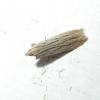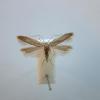35.078 Monochroa niphognatha (Gozmány, 1953)
Status and Distribution
Rare, known with regularity from only one site in Kent where it has been reported since 1984. Searches for larvae at this site from 2022-2024 produced small numbers of larvae each year. One-off reports of single adults have been received from Devon (2002), Hampshire (2009), Dorset (2017) and East Sussex (2019), suggesting it may be under-recorded as a breeding species (Beavan and Heckford, 2022).

Provisional map
Habitat
Finding the Moth
Larva: look for small holes in the stem of the foodplant in September, sometimes extruded frass being visible which may indicate the presence of a larva. Distinctively red-striped larva needs to be seen to exclude the possibility of a weevil species, the larva of which feeds in the stem of this plant.
Adult: sweeping areas of the foodplant may be worthwhile. It comes readily to light.
Similar Species
Similar to, but larger than, Monochroa suffusella.
Single brooded from mid-June to July.
Earliest: 20th June 1995 (VC15)
Latest: 8th July 1984 (VC15)
There is only very limited date information available.







